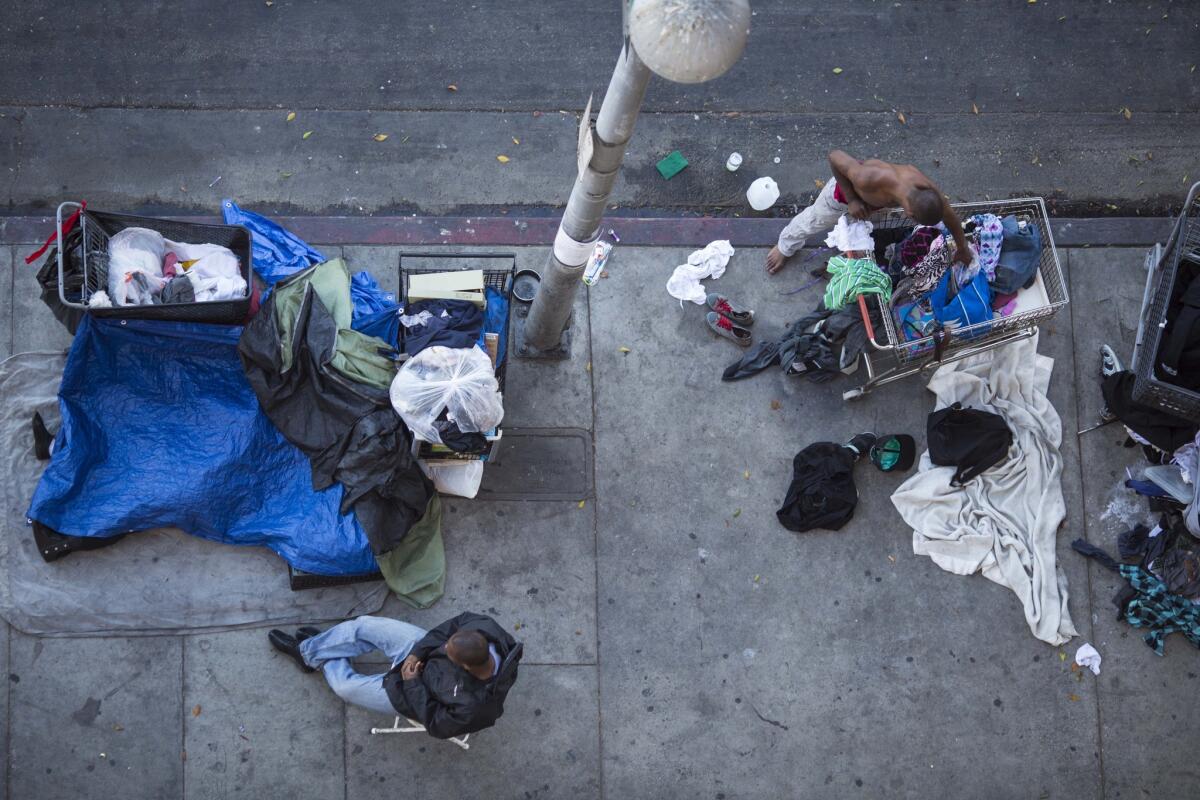Skid row: Renewed push for cleanups, social services for homeless

- Share via
Acknowledging that law enforcement alone had failed to end homelessness on skid row, officials launched a city-county initiative Tuesday to bring social services and enhanced cleanups to the 50-block downtown Los Angeles district.
“The seriousness of the situation makes this much more than a police issue,” Los Angeles City Councilman Jose Huizar said at a City Hall news conference.
Starting this week, city and county agencies will go into the streets to offer health and housing services to the estimated 1,700 people living in tents and cardboard boxes in the most concentrated homeless enclave in the nation.
The initiative builds on the city’s $3.7-million Operation Healthy Streets, which on Aug. 13 will start intensive bimonthly cleanings and spot touchups in the neighborhood.
The agencies involved include the Los Angeles Police Department; the Los Angeles County Departments of Mental Health, Health Services and Public Health; the L.A. City Attorney’s office; Los Angeles Homeless Services Authority, and the city’s Bureau of Sanitation.
Coordinating the effort are Huizar and Los Angeles County Supervisor Mark Ridley-Thomas, officials said. The county Department of Health Services is also moving its Housing for Health offices, which develop homeless housing linked to services, to skid row.
The city also plans to set up short-term storage areas for homeless people to stash their carts and other belongings. Under a court order, homeless people may sleep on the sidewalks overnight but can be required to remove their property in daytime hours.
Officials said it was the most advanced collaboration yet between the city and county, which have been blamed at times for working at cross-purposes in the decades-long quest to solve homelessness.
Under former Police Chief William Bratton, the city in 2006 launched the Safer Cities Initiative, a 50-officer task force that targeted quality-of-life infractions such as littering and jaywalking by homeless people on skid row.
This so-called “broken windows” approach brought down skid row street counts, but activists said many homeless people cycled in and out of jail or were driven into other neighborhoods. The homeless numbers on skid row came roaring back this year.
Officials also promised to maintain data on housing placement, medical coverage and detox and mental health treatment on skid row, both to measure their progress and to gauge unmet need.
“We can’t arrest our way out of this problem,” said Los Angeles Police Capt. Mike Oreb, head of the Central Area division. “It doesn’t change the alcohol abuse, narcotics abuse and mental health issues. ... We’re going to leave the other issues to the professionals.”
Huizar said he is also calling on the city to designate someone, in the mayor’s office or elsewhere, to head up the homeless push.
Skid row residents said they are cautiously optimistic about the new plan.
“This serious collaborative effort is absolutely essential and long overdue,” said skid row resident Tom Grode, a member of a neighborhood advisory board who attended the morning conference. “To feel encouraged about this I have to trust the people here are sincere in what they’re saying. That remains to be seen.”
Follow @geholland for news about skid row and other homeless issues.
More to Read
Sign up for Essential California
The most important California stories and recommendations in your inbox every morning.
You may occasionally receive promotional content from the Los Angeles Times.














